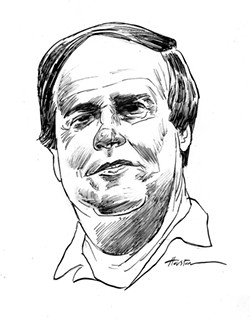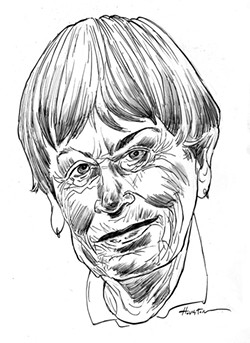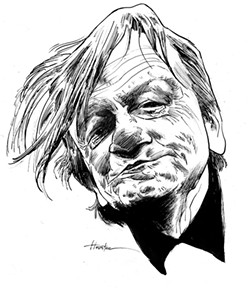One invented the green bean casserole. One predicted the rise of Vladimir Putin. Another brought St. Louis' restaurant community together, with a generous social media presence and a merrily named fourteen-seat passenger bus.
What unites the people whose lives we celebrate in this year-end issue? The answer, on its face, is grim: We remember them today because we lost them this year. Yet there is more than sadness in these pages. Reading these tributes, there is a clear sense of lives with purpose, with passion. Chief Wahoo aside, these are people who left this world a bit better than it was when they came into it.
We remember them today not necessarily as the biggest names that died in 2018, but the ones that made a personal impact on us. The ones whose stories intrigue us, whose quests impressed us, whose presences inspired us. May we learn from the lives they lived as we contemplate a new year without them.
Emily "Mount Fiji" Dole
Pioneer of female professional wrestling
Sept. 28, 1957–Jan. 2, 2018
In the late 1980s, to reach the peak of women's professional wrestling was to be among the cast members on the hit sports show GLOW: The Gorgeous Ladies of Wrestling. Hitting the airwaves in 1986, the all-female wrestling program consisted of women assigned flamboyantly cartoonish alter egos that couldn't have been further from political correctness, like Matilda the Hun, Babe the Farmer's Daughter, and the tag team Hollywood & Vine.
Considering the stress they put on their bodies, the female wrestling pioneers practically worked for free, making between $300 and $700 a week. There were no dental benefits, just the risk of losing teeth in the ring; no medical insurance for the inevitable broken collarbones and concussions. Their only guarantee at the end of the day was pain and exasperation — and, when the bright lights dimmed and the roar subsided, the glory.
But among the many talented ladies who initially scratched the surface of women in professional wrestling, none of them are remembered quite like the one they dubbed "Mountain Fiji." Legend has it Emily "Mount Fiji" Dole never lost a match, which makes sense when you consider that she stood 5 feet, 11 inches tall and weighed in at 350 pounds.
A proud Samoan American woman, an actress by any fair definition, an accomplished athlete, Dole was by far the most recognizable character on GLOW, with her tree trunk-like arms and shoulders as wide as a volcano's outer rim. Prior to her time as a professional wrestler, Dole was remembered for her ability to toss a shotput more than 50 feet as a teenager at Buena Park High School in California — a feat that's been repeated just twice by other California high school girls. Later, Dole qualified for two Olympic track and field trials, where she finished fifth in 1976 and seventh in 1980. Netflix's current fictionalized tribute to the pioneering wrestling league features a Samoan American wrestler named Carmen "Machu Picchu" Wade, played by Britney Young, a clear tribute to Dole's legacy.
In her final years, Dole dealt with a number of health problems, many of which were born from her career in wrestling, and had been staying in an assisted living facility. By 2008, her weight had begun to get the best of her as she climbed up to 425 pounds, although she would later cut it back down to 235 pounds.
But like all volcanoes, though it erupted hundreds of times within the wrestling ring, the fire inside Dole would inevitably lay dormant. On Jan. 2, 2018, Dole passed away from unknown complications. She was 60 years old.— Xander Peters
Thomas Bopp
Amateur astronomer and discoverer of Comet Hale-Bopp
Oct. 15, 1949–Jan. 5, 2018
Thomas Bopp wasn't looking for a comet when he peered into a telescope on Saturday, July 22, 1995. In fact, he wasn't looking for anything. By day, the 47-year-old worked for a cement company, where he made a passing mention of his interest in astronomy to Jim Stevens, who ran an auto parts store in Phoenix. It was a hobby started when Bopp was just a boy growing up in Youngstown, Ohio, when his father gave him his first telescope. Stevens, it turned out, was also interested in telescopes. By night, the two became amateur astronomers, going stargazing with Stevens' homemade telescope in the Arizona desert, with Steven serving as Bopp's mentor.
That was exactly what they were doing that night when Stevens trained his lens on a cluster of stars in the Sagittarius constellation shortly after 11 p.m. Stevens was eager for Bopp to take a look. But what he didn't realize was he had aimed his telescope directly at an unidentified flying object — what Bopp would later describe as "a little fuzzy glow."
In reality, it was a 46-mile-wide hunk of ice 577 million miles away, hurtling through space toward Earth.
The stakes were high — comets are a coveted catch for astronomers, since they are conventionally named after those who discover them. But first Bopp and Stevens had to notify Harvard University to officiate the discovery. This was not an easy task in the Arizona desert in the '90s.
After studying the object for several minutes to make sure it was not a star, Bopp got in his car and drove 20 miles to a truck stop to try and call Western Union from a pay phone to send a telegram to the Central Bureau of the International Astronomical Union at Harvard University, because yes, you could still send telegrams in the '90s. The Western Union representative didn't have an address, so Bopp hung up and got in his car and drove home. Around 3 a.m., he barged into his bedroom, woke his wife, found the address in an astronomy book, and sent the telegram with the comet's coordinates.
The next morning, Bopp got a call from the International Astronomical Union. Unbeknownst to Bopp, another astronomer — a real astronomer, Alan Hale, with a doctorate in astronomy and everything — had also spotted the comet within minutes of him, and had already emailed the coordinates to Harvard from his home in New Mexico. But once again, the stars aligned for Bopp: By what he later described as "bizarre chance," an IAU associate director happened to be in the office that Sunday and received the telegram. The comet, formally designated C/1995 O1, would be named Hale-Bopp, after both astronomers.
Bopp quit his day job to attend to the media maelstrom that followed. In 1997, the comet reached perihelion, or its closest point to the sun. It lit up the night sky for more than eighteen months, its long tail visible to the naked eye to millions of people in the northern hemisphere. It was the biggest, most visible comet since the Great Comet of 1811.
The comet brought some misfortune, too. In March 1997, 39 members of California death cult Heaven's Gate committed mass suicide, believing their bodies would be transported to an alien spacecraft following the comet. In the spring, when the comet was the closest to the Earth, Bopp's brother and sister-in-law were killed by a car while photographing the comet. "This has been the best week of my life," he told National Geographic. "And the worst."
In recent years, Bopp worked as a shuttle driver at a Toyota dealership. He died at a hospital in Phoenix at age 68 from liver failure.
"I can find another job, but this is something that happens once in 10,000 lifetimes," he told Newsweek when he quit his job to bask in the glow of Hale-Bopp. The comet is expected to next pass Earth in 4897. — Lee DeVito
Ursula K. Le Guin
Trailblazing speculative novelist
Oct. 21, 1929–Jan. 22, 2018
More than twenty novels, not counting several early works that remain unpublished. A dozen books on poetry. More than 100 short stories, collected throughout multiple volumes. Seven essay collections. Thirteen books for children. Five volumes of translation, including the Tao Te Ching of Lao Tzu and selected poems by the Chilean Nobel Prize winner Gabriela Mistral. Oh, and a guide for writers.
Even stingily speaking, the career of author Ursula K. Le Guin — one of the twentieth century's pioneering science fiction and young adult writers — was prolific. Arguably her most enduring work, The Left Hand of Darkness, inspired legions of genre writers, including contemporary savants such as Neil Gaiman, J.K. Rowling, John Scalzi and Margaret Atwood, author of The Handmaid's Tale. Some critics argue that no single work did more to upend the genre's seemingly predictable conventions than that of the Nebula and Hugo Award-winning novel, which imagined a world whose human inhabitants have no fixed gender; instead, their sexual roles are determined by context and express themselves only once a month. She would later refer to the story as a "thought experiment." "I eliminated gender to find out what was left," Le Guin told the Guardian in 2005. It remains one of speculative fiction's academic touchstones to this day.
The only daughter of two anthropologists, Ursula Kroeber was born the youngest of four children in Berkeley, California, in 1929. Her father studied Native American tribes based in California, while her mother, Theodora Kracaw Kroeber, gained prominence in the same field with Ishi in Two Worlds, which chronicled the life and death of the state's "last wild Indian." Throughout her youth, with dinner-table talk of lost worlds never far out of earshot, Le Guin would use her family's deep understanding of the world as a jumping-off point as she immersed herself in mythology, classic fantasies and the science fiction magazines of the day.
In 1951, she graduated from Radcliffe College, then earned a master's degree in romance literature from Columbia University in 1952. From there, Le Guin was awarded a Fulbright fellowship to study in Paris. While aboard a steamer set for France, she met the historian Charles Le Guin, whom she married a few months later. Later in life, the two would settle down and start a family in Portland, Oregon, where they lived in a Victorian house on a steep street just below the city's Forest Park. As the Paris Review noted during an interview with Le Guin in 2013, perhaps appropriately for a science fiction author and much like the worlds she'd bend within her fiction's narratives, their home appeared "larger on the inside than it does from without."
On Jan. 23, 2018, with one last conflict within a story to resolve, Le Guin passed away peacefully at her home in Portland. Her family did not cite a cause other than poor health due to old age. Le Guin was 88 years old. — Xander Peters
Mark E. Smith
Irascible frontman of the Fall
March 5, 1957–Jan. 24, 2018
"If it's me and your granny on bongos, then it's a Fall gig."
A young Mark E. Smith started the Fall in the Manchester suburb of Prestwich after that infamous 1976 Sex Pistols show in Manchester that inspired the majority of attendees to start bands the next day. It was the only time in his life that Smith would (unwittingly) succumb to rock cliché. He spent the next 40 years trying his best to dismantle rock & roll and the music industry from the inside.
Though he looked like an ill-tempered postal clerk or substitute teacher, Smith was punk and disorderly to the very core. With the Fall, he built a sound antithetical to the idea of musical proficiency, favoring instead spontaneity and creative tension, laced it with biting, clever, often poetic lyrics, and ended up with something every bit as inspirational as Gang of Four or Wire. The Fall were a band that (to their horror, perhaps) influenced generations of punk, new wave and alternative rock bands, and Smith became a de facto role model to those for whom the underground was more than just a temporary lifestyle choice. What other post-punk band had enough cultural cachet to score a major label record deal (again), during the grunge revolution of the 1990s?
The unforgettable songs and anthems piled up like discarded ex-band members (a cohort more than 60 strong) — "Totally Wired," "Mr. Pharmacist," "The Classical," "Hip Priest," "Glam Racket," "Ghost in My House," "Big New Prinz." Did you ever hear the Fall's cover of disco standard "Lost In Music"? If the albums aren't enough to slake your thirst, the Fall recorded twenty-plus live sessions with equally legendary British DJ John Peel over the BBC's public radio airwaves between 1978 and 2004.
Despite this fearsome productivity, Smith kept the Fall proudly "unprofessional." If during a concert Smith would drink himself into oblivion, unplug an amp (or five), mess up keyboard settings, change up the setlist, or recruit a new drummer fifteen minutes before showtime, what of it? As Smith himself barked, it's just "creative management, cock!" Smith was the Fall's only constant member during the band's 40-plus years of intense creative drive (they were contemporaries of Joy Division, just to put things in perspective): one or more albums a year, restless, constantly changing music, grueling touring schedules that have the logistical sense of darts thrown at a map of the world, and a bandleader who apparently hasn't eaten solid food in decades (subsisting on a liquid diet, as they say) dedicated to spontaneity, conflict, and uncertainty in day-to-day business affairs.
Smith anecdotes are almost as legion as Fall anthems, suffused with a sui generis cranky mystique. There's the apocryphal story of him catching some of his bandmates dancing to "Rock the Casbah" at an afterparty in the '80s and summarily delivering slaps to every offender, or when he almost singlehandedly bottled Mumford & Sons off the stage in the early '00s; the time he fired a sound engineer for eating a salad, and fired a drummer on the unlucky percussionist's wedding day; or when he agreed to play on British chat show Later... With Jools Holland with the contractual condition that the titular host not play "boogie-woogie piano anywhere near the Fall."
His neverending embrace of chaos and tension had an ugly side; he could be vile and abusive to those closest to him. And yet, most remained loyal, believing in their flawed leader's vision. That included the long-suffering Hanley brothers and Smith's most famous creative foil, guitarist and ex-wife Brix Smith. Brix was the most iconic member of the Fall, after Smith, a glammed-up American punk who contributed unforgettable serrated riffs to pivotal albums including The Wonderful and Frightening World of the Fall and The Frenz Experiment. Photos and video from her tenure in the Fall are electrifying viewing, like transmissions from a strange alternate future. Their breakup was equally as seismic, though she rejoined the band for a brief time in the 1990s.
Smith died at 60 after a long battle with cancer, but was still doing shows, in a wheelchair, in the year before he passed, and never ceased writing and releasing music regularly. There will likely never be a pop star quite like him again. — Matthew Moyer










